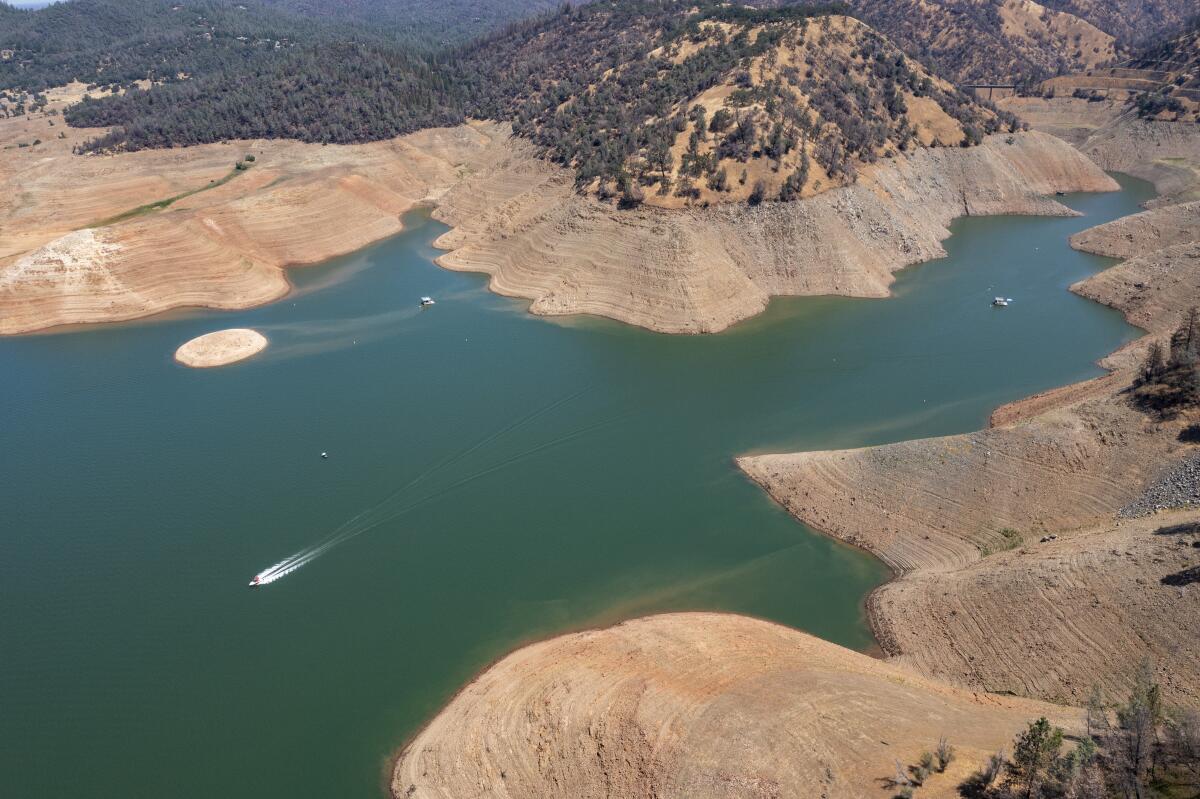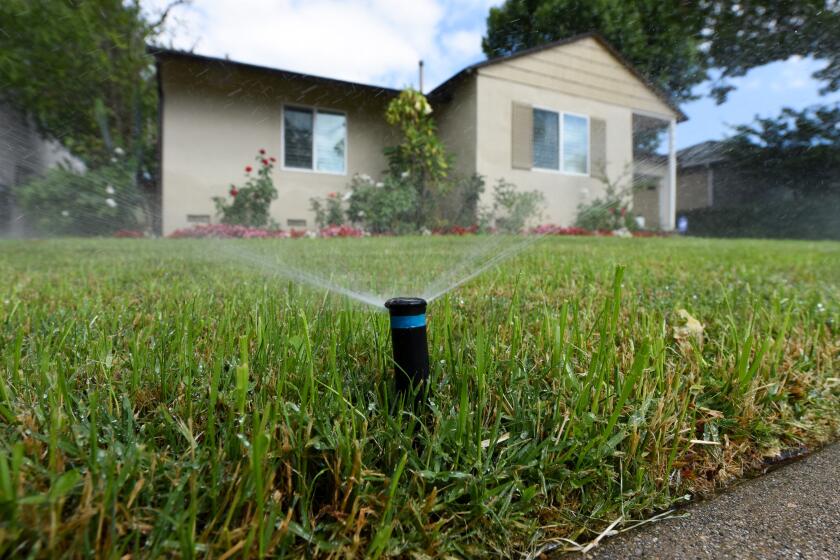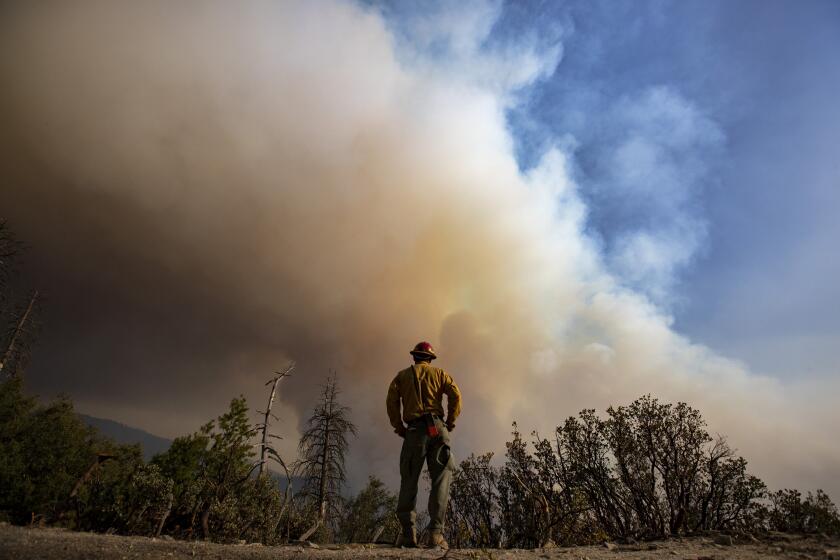California will consider mandatory water restrictions if dryness continues this winter

- Share via
With California’s extreme drought persisting and reservoirs declining to new lows, state officials said they will consider imposing mandatory water restrictions if dryness continues this winter.
Gov. Gavin Newsom called on Californians in July to voluntarily reduce water use by 15%, saying state water regulators would track progress toward that target and decide whether additional measures would be necessary.
Natural Resources Secretary Wade Crowfoot said Thursday that bigger steps may be needed if the drought doesn’t ease this winter, and turning to statewide mandatory conservation measures will be an option.
“We’re going to be watching very closely here in the coming couple few months how that voluntary water conservation goes,” Crowfoot said in a call with reporters. “We’ve achieved 16% water-use reduction since the last drought. So we know that Californians can step up. But the governor has been clear that we need to consider additional actions, and mandatory restrictions, you know, need to be on the table here as, if and when the drought worsens.”
Californians in cities and towns across the state reduced water use by 1.8% overall in July as compared with the same month last year. State officials said they’ll be watching to see how the water conservation numbers look for August and subsequent months.
Crowfoot said the state has been focusing on supporting cities and water agencies in pursuing “customized approaches” to conservation based on their different drought situations, and has been scaling up California’s Save Our Water campaign to get the word out about the need to conserve.
Despite a request by Gov. Gavin Newsom to voluntarily reduce water use by 15%, Southern California has yet to start conserving, figures show
He and other state water officials spoke ahead of the Oct. 1 start of the new water year. California gets much of its rain and mountain snow between November and March, and the next several months will determine whether the state must cope with a third dry winter.
“Heading into this winter, we’ll be watching, one, how Californians do on voluntary conservation toward that 15%,” Crowfoot said. “There’s no set sort of trigger date for considering mandatory conservation, but we’ll be watching it closely.”
Though California naturally goes through dramatic swings between dry spells and deluges, higher temperatures brought on by climate change are making droughts more intense.
The snowpack this year in the northern Sierra Nevada, which feeds the state’s reservoirs, peaked at 72% of average in April, and then rapidly melted during the hottest spring on record. Extreme heat has baked much of the West and left parched soils, which have soaked up a portion of the runoff and left diminished flows in rivers.
Gov. Gavin Newsom on Thursday expanded his regional drought state of emergency to apply to 50 California counties, or roughly 42% of the state’s population.
“Drought is part of California’s natural environment, but is now supercharged by accelerating climate change,” Crowfoot said. “Those high temperatures meant that more of our melting snow in the mountains either was absorbed into very dry soils or evaporated into the air.”
This second year of drought, he said, has created conditions comparable to the severe drought of 1976-77. There was less precipitation in 1977 than this year. But the amount of runoff in streams and rivers ended up being about the same, state officials say, because of the hotter temperatures.
“Science that we funded five to 10 years ago anticipated the impacts that we’re experiencing now being experienced at the end of this century,” Crowfoot said. “So we are really working nimbly to adapt to climate change.”
The drought has left California reservoirs from Lake Shasta to San Luis Reservoir at some of their lowest levels ever.
Cities and water districts have obtained just 5% of their full water allotments this year from the State Water Project, which delivers water with pumps and canals from the Sacramento-San Joaquin River Delta to Southern California. And the Colorado River, also a major source for Southern California, is headed for a federally declared shortage next year.
The approval of $15 billion to address the worsening effects of global warming was announced amid Climate Week
“Conditions across California differ but are growing worse,” Crowfoot said. “All areas of the state will have big problems if we have another, third dry winter in a row.”
For part of the 2012-16 drought, then-Gov. Jerry Brown ordered a mandatory 25% reduction in urban water use. Many Californians responded by cutting back and taking steps such as converting lawns to drought-tolerant plants. Many of these changes have had a lasting effect in reducing water use.
Department of Water Resources Director Karla Nemeth said it’s time for “that next leap in conservation ethic.”
“Whether or not that needs a mandatory push to make it happen, I think remains to be seen. But those are conversations we’re having. And it is definitely on the table as a tool,” Nemeth said.
There are some steps short of statewide mandatory restrictions that could also be taken, Crowfoot said, such as prohibitions on hosing down driveways or other water-saving rules. And local water suppliers can activate shortage measures on their own.
“We’ve heard from local water agencies that they really want to take the lead on weathering through the drought,” Crowfoot said, adding that the time is now to urge “local water partners to step up and to demonstrate water conservation.”
The State Water Resources Control Board has been tracking the monthly water usage of more than 400 cities, towns and water districts.
If the board moves toward mandatory reductions in urban water use, officials would look to have not a “one-size-fits-all” approach but one that would account for how much different communities have already conserved, said Joaquin Esquivel, the board’s chairperson.
Just as the declining reservoirs are leading to shortages, the low water levels in streams pose serious threats for fish such as Chinook salmon.
“Streams across the state are growing warm and disconnected,” Crowfoot said. “And as a result, the Department of Fish and Wildlife is monitoring conditions and wherever possible relocating native fish, as well as amphibians, and increasing hatchery production to make up for loss as a result of these conditions.”
He and other officials touted California’s newly approved $15-billion budget package for addressing climate change, drought and wildfires, which Newsom signed last week.
The budget includes $5.1 billion to support drought response efforts and water projects. Portions of the funds are to go toward water infrastructure projects, water recycling, flood management and efforts to protect watersheds and ecosystems, among other things.
“It’s a quantum leap of investment,” Crowfoot said. “Our policymakers are quickly leading the effort to adapt to these changes. But these climate changes are coming fast and furious.”
Esquivel said these investments will help the state “stretch through these dry times.”
The drought has also affected deliveries of water to agriculture. This summer, the state water board issued an emergency order barring thousands of water rights holders, including farmers and other landowners, from diverting water from the delta.
“This is the first drought where we’ve had such an extensive landscape impacted by the drought conditions,” Food and Agriculture Secretary Karen Ross said. “The curtailment process has been especially painful this year, although it came late in the year, when many of our crops, annual crops, were already in the ground, and people were just trying to finish out the crops.”
She said the budget package brings critical funding that will help the state capitalize in years when atmospheric rivers bring deluges, which can be captured and used to recharge depleted aquifers.
Ross said the funding will also “improve our resiliency and our ability to survive from one drought to the next.”









